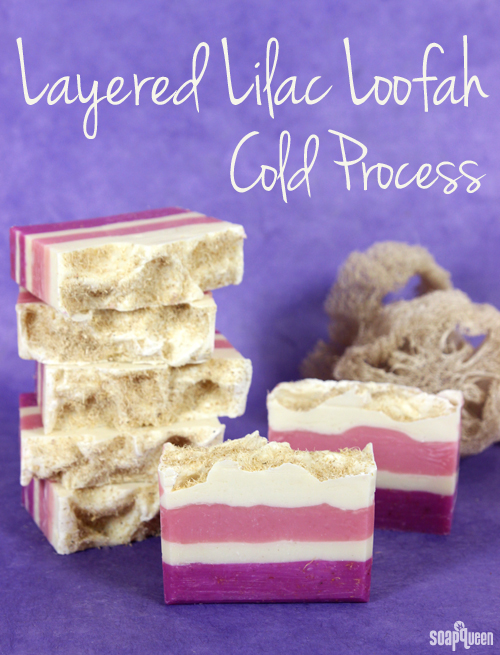
When planning a cold process soap design, fragrance oil selection plays a huge role. Some fragrance oils discolor brown (learn more about that here), making bright colors difficult. Other fragrance oils accelerate trace, which can make complicated designs like a Column Pour or a Peacock Swirl tricky to execute. Floral fragrances are known for their tendency to accelerate trace, but that doesn’t mean beautiful soap can’t be created with them! It just means you need to choose an appropriate design, and be ready to work fast. Setting up your soaping workspace beforehand helps immensely!
This Layered Lilac Loofah (say that ten times fast!) Cold Process project was created with acceleration in mind. Lilac Fragrance Oil tends to speed up trace, making layers a perfect design for this fragrance. Because the soap becomes thick quickly, it is able to support the layers on top. With plenty of butters and a bit of scrub from shredded loofah, this palm-free recipe leaves skin feeling incredibly soft.
What You’ll Need:
10″ Silicone Loaf Mold
3.6 oz. Avocado Oil
1.8 oz. Castor Oil
7.2 oz. Cocoa Butter
9 oz. Coconut Oil
3.6 oz. Green Tea Seed Oil
1.8 oz. Mango Butter
7.2 oz. Olive Oil
1.8 oz. Shea Oil
5 oz. Sodium Hydroxide
11.9 Distilled Water
Radiant Plum Colorant
Titanium Dioxide Pigment
Ultramarine Lavender Pigment
Electric Bubblegum Colorant
2.5 oz. Lilac Fragrance Oil
1 tbs. Shredded Loofah
 Click here to add everything you need for this project to your Bramble Berry shopping cart!
Click here to add everything you need for this project to your Bramble Berry shopping cart!
If you’ve never made Cold Process soap before, stop here! I highly recommend checking out our FREE four part SoapQueen.tv series on Cold Process Soapmaking, especially the episode on lye safety. And if you’d rather do some reading, Bramble Berry carries a wide range of books on the topic, including my newest book, Soap Crafting. You can also checkout the digital downloads for that instant gratification factor.
SAFETY FIRST: Suit up for safe handling practices! That means goggles, gloves and long sleeves. Make sure kids, pets, and other distractions and tripping hazards are out of the house or don’t have access to your soaping space. Always soap in a well-ventilated area.
COLOR PREP: Disperse 1 teaspoon of each colorant into 1 tablespoon of sunflower or sweet almond oil (or any other liquid oil). Use a mini mixer to get clumps worked out smoothly. Prepping your colors in the beginning will allow you to work quickly and give you more time to work with your soap.
ONE: Slowly and carefully add the lye to the water and gently stir until the lye has fully dissolved and the liquid is clear. Set aside to cool.
TWO: Melt and combine the cocoa butter, mango butter, coconut, olive, shea, green tea seed, castor and avocado oils. Once the lye water and the oils have cooled to 130 degrees or below (and are ideally within 10 degrees of each other), add the lye water to the oils and stick blend until very thin trace. If you’d like a harder bar of soap that releases faster from the mold, you can add Sodium Lactate to the cooled lye water. Use 1 teaspoon of Sodium Lactate per pound of oils in the recipe. For this recipe, you’d add about 2 tsp. Sodium Lactate.
Note: Because this fragrance oil causes the trace to accelerate quickly, be sure to stop stick blending once you have reached a very thin trace. You can always blend more later!
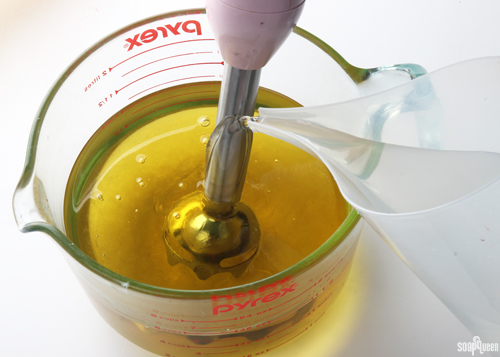
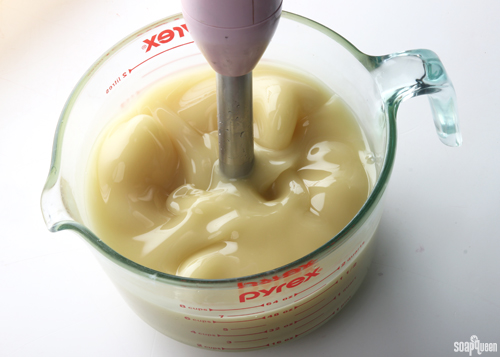 TWO: Once you’ve reached a thin trace, pour 1.5 cups of soap into two small containers. To one small container, add 1 tbs. Radiant Plum Colorant and 1 tbs. shredded loofah, and stir with a whisk to fully incorporate.
TWO: Once you’ve reached a thin trace, pour 1.5 cups of soap into two small containers. To one small container, add 1 tbs. Radiant Plum Colorant and 1 tbs. shredded loofah, and stir with a whisk to fully incorporate.
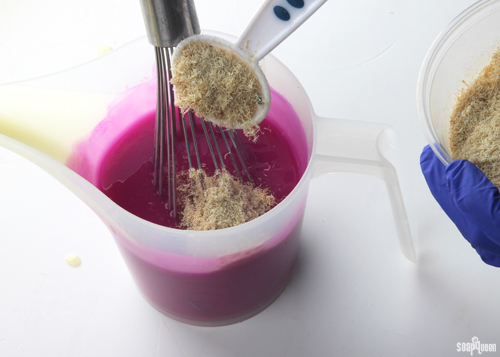 THREE: Add .75 ounces of Lilac Fragrance Oil, and use a whisk to thoroughly combine.
THREE: Add .75 ounces of Lilac Fragrance Oil, and use a whisk to thoroughly combine.
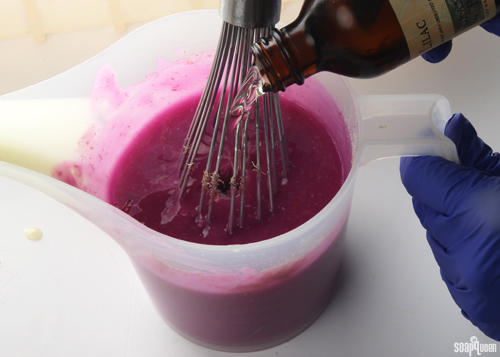 FOUR: Pour the purple soap into the mold, and tap the mold down firmly on the counter to evenly disperse the soap. Notice how quickly the soap thickens!
FOUR: Pour the purple soap into the mold, and tap the mold down firmly on the counter to evenly disperse the soap. Notice how quickly the soap thickens!
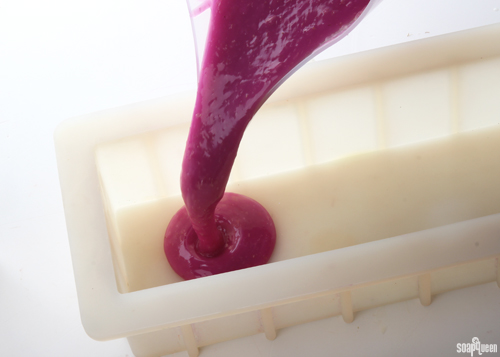 FIVE: To the large container of soap, add 1 tbs. titanium dioxide and 1 oz. of Lilac Fragrance Oil. Use a whisk to thoroughly combine.
FIVE: To the large container of soap, add 1 tbs. titanium dioxide and 1 oz. of Lilac Fragrance Oil. Use a whisk to thoroughly combine.
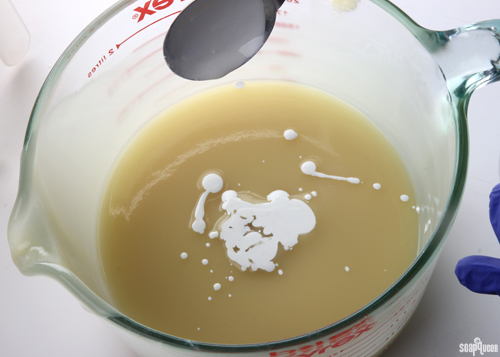 SIX: Gently pour about half of the white soap into the mold. In order to avoid the white soap from breaking through into the purple layer, you may choose to pour the soap over a spatula into the mold. Use the spatula to evenly distribute the white soap, and tap the mold firmly on the counter to release any bubbles.
SIX: Gently pour about half of the white soap into the mold. In order to avoid the white soap from breaking through into the purple layer, you may choose to pour the soap over a spatula into the mold. Use the spatula to evenly distribute the white soap, and tap the mold firmly on the counter to release any bubbles.
 SEVEN: To the remaining small container, add 1 tsp. of Ultramarine Lavender Pigment and 1/2 tsp. of Electric Bubblegum Colorant. Add .75 ounces of Lilac Fragrance Oil, and use a whisk to completely combine.
SEVEN: To the remaining small container, add 1 tsp. of Ultramarine Lavender Pigment and 1/2 tsp. of Electric Bubblegum Colorant. Add .75 ounces of Lilac Fragrance Oil, and use a whisk to completely combine.
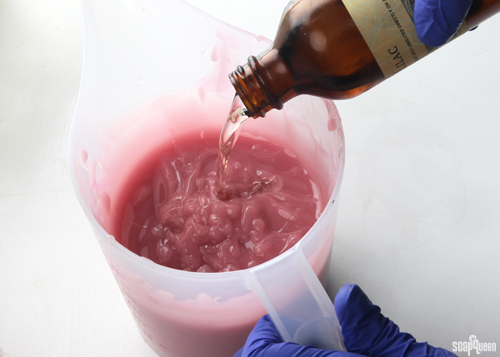 EIGHT: Gently pour the pink soap into the mold. At this point, the soap will be very thick. In order to avoid the pink soap from breaking through into the white layer, you may choose to pour the soap over a spatula into the mold. Use the spatula to evenly distribute the white soap, and tap the mold firmly on the counter to release any bubbles.
EIGHT: Gently pour the pink soap into the mold. At this point, the soap will be very thick. In order to avoid the pink soap from breaking through into the white layer, you may choose to pour the soap over a spatula into the mold. Use the spatula to evenly distribute the white soap, and tap the mold firmly on the counter to release any bubbles.
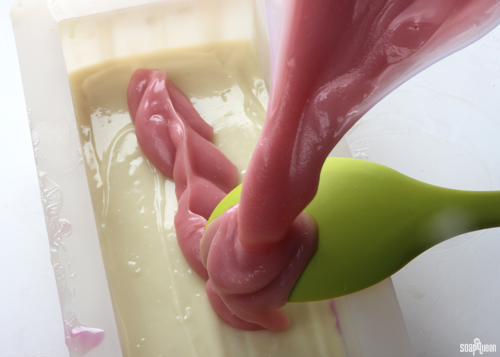 NINE: Slowly and carefully pour the remaining white soap into the mold. We found the pink soap was firm enough that pouring over a spatula was not necessary. Use a spoon to create a textured top. Because the soap will be a very thick trace, it is easy to create texture. No need to be precise, have fun creating peaks!
NINE: Slowly and carefully pour the remaining white soap into the mold. We found the pink soap was firm enough that pouring over a spatula was not necessary. Use a spoon to create a textured top. Because the soap will be a very thick trace, it is easy to create texture. No need to be precise, have fun creating peaks!
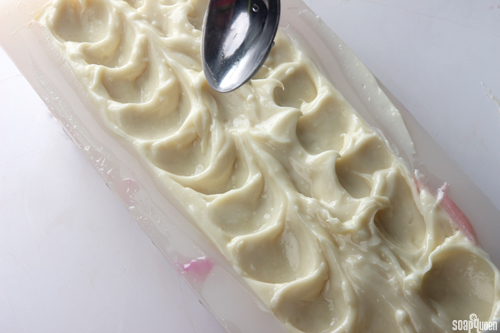 TEN:Once you are happy with the texture, sprinkle shredded loofah on top. Keep in mind some loofah will fall off, so don’t be shy!
TEN:Once you are happy with the texture, sprinkle shredded loofah on top. Keep in mind some loofah will fall off, so don’t be shy!
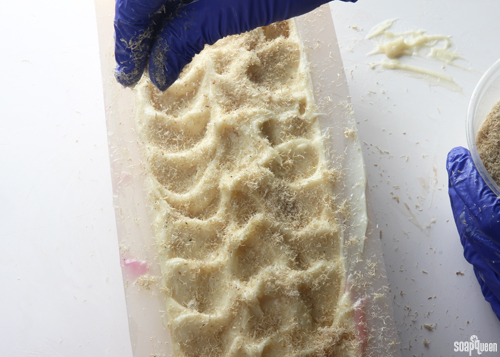 Spray with isopropyl alcohol, place a piece of cardboard and a blanket over the mold and place on a heating pad for 15 – 20 minutes. Then, remove from heat and let it sit overnight. Allow the soap to cure for 4 – 6 weeks and then enjoy!
Spray with isopropyl alcohol, place a piece of cardboard and a blanket over the mold and place on a heating pad for 15 – 20 minutes. Then, remove from heat and let it sit overnight. Allow the soap to cure for 4 – 6 weeks and then enjoy!

- 10″ Silicone Loaf Mold
- 3.6 oz. Avocado Oil
- 1.8 oz. Castor Oil
- 7.2 oz. Cocoa Butter
- 9 oz. Coconut Oil
- 3.6 oz. Green Tea Seed Oil
- 1.8 oz. Mango Butter
- 7.2 oz. Olive Oil
- 1.8 oz. Shea Oil
- 5 oz. Sodium Hydroxide
- 11.9 Distilled Water
- Radiant Plum Colorant
- Titanium Dioxide Pigment
- Ultramarine Lavender Pigment
- Electric Bubblegum Colorant
- 2.5 oz. Lilac Fragrance Oil
- 1 tbs.Shredded Loofah
- SAFETY FIRST: Suit up for safe handling practices! That means goggles, gloves and long sleeves. Make sure kids, pets, and other distractions and tripping hazards are out of the house or don’t have access to your soaping space. Always soap in a well-ventilated area.
- COLOR PREP: Disperse 1 teaspoon of each colorant into 1 tablespoon of Sunflower or Sweet Almond Oil (or any other liquid oil). Use a mini mixer to get clumps worked out smoothly. Prepping your colors in the beginning will allow you to work quickly and give you more time to work with your soap.
- Slowly and carefully add the lye to the water and gently stir until the lye has fully dissolved and the liquid is clear. Set aside to cool.
- Melt and combine the cocoa butter, mango butter, coconut, olive, shea, green tea seed and avocado oils. Once the lye water and the oils have cooled to 130 degrees or below (and are ideally within 10 degrees of each other), add the lye water to the oils and stick blend until thin trace. If you’d like a harder bar of soap that releases faster from the mold, you can add Sodium Lactate to the cooled lye water. Use 1 teaspoon of Sodium Lactate per pound of oils in the recipe. For this recipe, you’d add about 2 tsp. Sodium Lactate.
- Once you’ve reached a thin trace, pour 1.5 cups of soap into two small containers. To one small container, add 1 tbs. Radiant Plum Colorant and 1 tbs. shredded loofah, and stir with a whisk to fully incorporated.
- Add .75 ounces of Lilac Fragrance Oil, and use a whisk to thoroughly combine.
- Pour the purple soap into the mold, and tap the mold down firmly on the counter to evenly disperse the soap.
- To the large container of soap, add 1 tbs. titanium dioxide and 1 oz. of Lilac Fragrance Oil. Use a whisk to thoroughly combine.
- Gently pour about half of the white soap into the mold. In order to avoid the white soap from breaking through into the purple layer, you may choose to pour the soap over a spatula into the mold. Use the spatula to evenly distribute the white soap, and tap the mold firmly on the counter to release any bubbles.
- To the remaining small container, add 1 tsp. of Ultramarine Lavender Pigment and ½ tsp. of Electric Bubblegum Colorant. Add .75 ounces of Lilac Fragrance Oil, and use a whisk to completely combine.
- Gently pour the pink soap into the mold. At this point, the soap will be fairly thick. In order to avoid the pink soap from breaking through into the white layer, you may choose to pour the soap over a spatula into the mold. Use the spatula to evenly distribute the white soap, and tap the mold firmly on the counter to release any bubbles.
- Slowly and carefully pour the remaining white soap into the mold. We found the pink soap was firm enough that pouring over a spatula was not necessary. Use a spoon to create a textured top. No need to be precise, have fun creating peaks!
- Once you are happy with the texture, sprinkle shredded loofah on top. Keep in mind some loofah will fall off, so don’t be shy!
- Spray with isopopyl alcohol and then insulate the soap and place on a heating pad for 15 – 20 minutes. Then remove from heat and cover it overnight. Allow the soap to cure for 4 – 6 weeks and then enjoy!

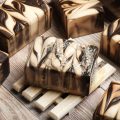
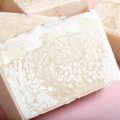
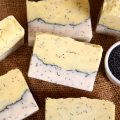

Hi just checking is it really 7.2 oz of cocoa butter or is that a mistake – seems like an awful lot of cocoa butter?
Many thanks
It does seem a bit high! I’m going to double check Tuesday when I get into the office. Once I know I’ll contact you. 🙂
-Kelsey with Bramble Berry
Hi Kate!
That butter amount is correct! Because this is a palm-free recipe, it has a bit more butter. That will help make the soap a bit more firm to make up for the missing palm oil. 🙂
-Kelsey with Bramble Berry
Hi Kelsey, thanks for your reply 🙂
You’re welcome! 🙂
In this step:
FOUR: Pour the purple soap into the mold, and tap the mold down firmly on the counter to evenly disperse the soap. Notice how quickly the soap thickens!
how can I do for soap thick quickly?
thank you
Hi Nawarat!
The Lilac Fragrance Oil used in this recipe accelerates. That means it starts to thicken the soap as you’re working with it. You’ll notice after you add the fragrance and whisk it in it will start to thicken. By the time you’re pouring the purple soap, it will be at medium to thick trace. That acceleration lends itself perfectly to this design, as the thick soap helps support the layers!
So all you have to do is add the Lilac Fragrance Oil and the soap will thicken on its own. If you want it even thicker, you can stick blend the soap until it’s the texture of thick pudding. 🙂
Read more about trace in this post: http://www.soapqueen.com/bath-and-body-tutorials/tips-and-tricks/trace/
-Kelsey with Bramble Berry
Lilac Fragrance Oil: https://www.brambleberry.com/Lilac-Fragrance-Oil-P3891.aspx
Can you substitute Jasmine for the lilac fragrance? I love the look of the soap but lilac is not one of my favorite smell. Thanks!
Hi Terri!
Absolutely! Jasmine fragrances tend to accelerate as well, so this layered design will work nicely with that. If you’ve never worked with the fragrance before, you may want to make a small test batch just to be extra careful. 🙂
To find out how much fragrance to add, you can use our Fragrance Calculator: http://www.soapqueen.com/bath-and-body-tutorials/tips-and-tricks/use-fragrance-calculator/
-Kelsey with Bramble Berry
Hello, is it safe for me to assume that the castor oil is added along with the rest of the oils
Hi Sheila!
That is correct! We mix all our base oils in one container, then add the lye and water mixture and stick blend. Sorry for any confusion! I updated the blog post to make that more clear. 🙂
-Kelsey with Bramble Berry
Hi Soapqueen,
This looks gorgeous! Would the recipe work for the 2 pound wood mold? Thank you.
Hi Celine!
So glad you like the soap! You can definitely make this soap in the 2 lb. Wood Mold. You can resize it using our Lye Calculator. I’ll include a post that shows you how to do so. 🙂
-Kelsey with Bramble Berry
Using the Bramble Berry Lye Calculator: http://www.soapqueen.com/bath-and-body-tutorials/cold-process-soap/using-the-bramble-berry-lye-calculator-2/
2 lb. Wood Loaf Mold: https://www.brambleberry.com/2-lb-Wood-Loaf-Mold-P5239.aspx
Thank you Kelsey!!!
You are very welcome! 🙂
-Kelsey with Bramble Berry
Love the way this looks! Just found out my daughter is allergic to coconut oil! Her favorite smell is lilac! What could I use in place of the coconut oil?
Hi Jan!
So glad you like the recipe! There is no direct replacement for coconut oil, but you can definitely leave it out of this recipe.
You can replace the 9 oz. of coconut oil with olive oil. Coconut oil creates a nice firm, cleansing bar, so adding that extra olive oil will make this recipe softer. That means it can take up to 1-2 weeks to unmold and up to 6 months to cure. It will create a nice luxurious bar though!
Also, we definitely recommend adding that sodium lactate to speed up that process. 🙂
-Kelsey with Bramble Berry
Formulating Cold Process Recipes: http://www.soapqueen.com/bath-and-body-tutorials/tips-and-tricks/formulating-cold-process-recipes/
Sunday Night Spotlight: Sodium Lactate: http://www.soapqueen.com/bramble-berry-news/sunday-night-spotlight-sodium-lactate/
I am just wondering what other Brambleberry fragrance oils would have the effect of speeding up trace and could be used in this recipe?
Thank you!!!
Hi Laurel!
Floral fragrances tend to speed up trace, so those would be a good option! Also, you can check the descriptions of our fragrances on brambleberry.com. Each fragrance says whether it accelerates or not. 🙂
-Kelsey with Bramble Berry
Floral fragrances: https://www.brambleberry.com/Floral-C165.aspx
I have a question. It may seem silly, but I am totally serious. Down here in deep south Texas we seem to have a lot of problems with plumbing issues. Will the shredded loofah pose a problem?
Hi Jenna!
We use soap with loofah frequently and haven’t experienced any plumbing issues. You may want to ask your local plumber just to be sure though! 🙂
-Kelsey with Bramble Berry
I love the idea of this recipe but I don’t use anything that I have to add lye too. (reason: don’t want to risk my son getting into it) I only use melt and pour soap. Could this be done with a melt and pour soap or possibly a rebatch soap. If so, what changes would need to be made. Thanks.
Hi Louise!
You can make this with melt and pour, but it will be different than the cold process version! Instead of powdered colorants, you can use our color blocks for melt and pour. Simply shave off pieces of the color blocks into your melted soap and mix well.
Color blocks for melt and pour: https://www.brambleberry.com/Color-Blocks-for-Melt-Pour–C340.aspx
Before you add the shredded loofah, you’ll want your soap to be around 130F. That way the soap is thick enough to suspend the loofah and it won’t sink to the bottom.
Also, make sure to spray 99% isopropyl alcohol on the bottom layer before you pour the next one. That will ensure those layers stick together. I’ll include a video that talks more about melt and pour layers. 🙂
Soap Queen TV: Basic Layers: https://www.youtube.com/watch?v=5oyh1Bf3Gxo
-Kelsey with Bramble Berry
Kelsey,
Thank you for your help. I can’t wait to try and once I do I will let you know how it came out. Happy New Year.
Thanks you,
Louise
Dear Soapqueen,
Can you tell me what chemical component in the fragrance causes the acceleration of trace? And does it occur with all oils/butters? or more or less with certain oil/butters?
With kind regards,
Annemieke
Hi Annemieke!
I’m not sure of the exact component of the fragrance that causes the acceleration! The fragrance blends are trade secret, meaning even we don’t know exactly what’s in them. However, I can tell you it occurs in most floral fragrance oils.
The acceleration will occur will all oils and butters. However, this recipe is palm free and has a lot of soft oils, meaning you have more time to work with it. If you want to slow the acceleration down even further, you can decrease the hard oils (coconut oil and cocoa butter) and add more soft oils. 🙂
-Kelsey with Bramble Berry
This is probably going in my top ten favorite recipes! Lilac is my favorite flower and purple is one of my favorite colors! I have shredded and whole loofah so I may need to try this soap!
Hi Leanna!
I’m so happy you enjoy the recipe! I love lilac too. 🙂
-Kelsey with Bramble Berry
Looks like a great recipe. I have everything except green tea seed oil. Can I substitute it for pumpkin seed oil? Thank you for such a great website – Soap Queen has been my go-to source for a treasure trove of information and inspiration since I started soaping over a year ago. You and your staff rock! Merry Christmas!
Hi Shannon!
I’m so happy you like the recipe!
Green tea seed oil is a nice lightweight oil that’s light in color. Pumpkin seed oil, on the other hand, is pretty thick and has a dark rich color. It may be tricky to add it to this recipe as it will change the consistency and your soap batter will be a lot darker, making it hard to get the bright white layer.
Instead of substituting the green tea seed oil, you can leave it out of this recipe. Then, you can increase one of the other oils, like the olive oil. Just make sure to run that recipe through the Lye Calculator again so you get the correct lye and water amounts. 🙂
-Kelsey with Bramble Berry
Lye Calculator: https://www.brambleberry.com/Pages/Lye-Calculator.aspx
Free Beginner’s Guide to Soapmaking: Common Soapmaking Oils: http://www.soapqueen.com/bath-and-body-tutorials/tips-and-tricks/free-beginners-guide-to-soapmaking-common-soapmaking-oils/
I like this – simple and striking and can be used with any fragrance/color combo. I like the printable recipe card too! However it never prints a picture of the item.
Hi Michael!
I’m so glad you like the recipe! Also, I’m glad you like the printable card! That was a feature we were really excited about.
Thanks so much for letting us know about the picture. That is something we will definitely look into. 🙂
-Kelsey with Bramble Berry